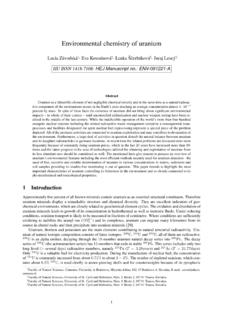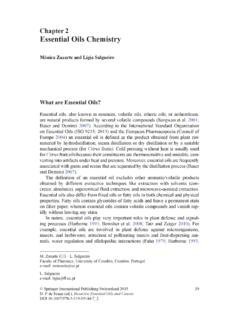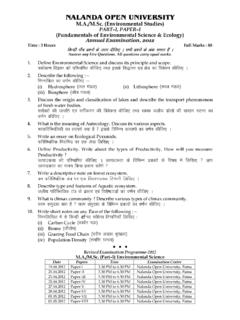Transcription of industry’s ability to help drive economic growth and job ...
1 1 May 15, 2017 EPA Regulatory Reform Task Force c/o Sarah Rees Director, Office of Regulatory Policy and Management Office of Policy (mail code 1803A) Environmental Protection Agency 1200 Pennsylvania Avenue NW Washington, DC 20460 Submitted electronically via Re: Docket EPA-HQ-OA-2017-0190 Dear Dr. Rees: The American Chemistry Council (ACC)1 welcomes the opportunity to comment on existing EPA regulations in need of repeal, replacement, or modification in response to the Federal Register notice published on April 13, 2017 (82 FR 17793). ACC has publicly called for and supported efforts to better address the burden of regulation and implement regulatory reform. The chemical industry needs a sound regulatory landscape in order to maximize the historic competitive advantage provided by shale gas.
2 This shale gas advantage represents a game-changer for manufacturing, and the Administration can and should leverage this competitive advantage through improved public policy. Reducing overly complex regulatory burdens is a key step for enhancing the chemical industry s ability to help drive economic growth and job creation throughout the broader economy. ACC represents a diverse set of companies engaged in the business of chemistry, which drives innovations that enable a more sustainable future, provides 810,000 manufacturing and high-tech jobs plus nearly six million related jobs that 1 The American Chemistry Council (ACC) represents the leading companies engaged in the business of chemistry. ACC members apply the science of chemistry to make innovative products and services that make people's lives better, healthier and safer.
3 ACC is committed to improved environmental, health and safety performance through Responsible Care , common sense advocacy designed to address major public policy issues, and health and environmental research and product testing. The business of chemistry is a $797 billion enterprise and a key element of the nation's economy. It is one of the nation s largest exporters, accounting for ten cents out of every dollar in exports. Chemistry companies are among the largest investors in research and development. Safety and security have always been primary concerns of ACC members, and they have intensified their efforts, working closely with government agencies to improve security and to defend against any threat to the nation s critical infrastructure. 2 support families and communities, and enhances safety through a diverse set of products and investments in R&D.
4 Existing Regulations Deserve More Scrutiny Historically, agencies, including EPA, spend relatively little time on improving existing regulations through retrospective review and devote the bulk of their resources to the development and issuance of new regulations and regulatory requirements. This is unfortunate, because the country could achieve greater protection at less cost if it were to regulate in a smarter manner, such as focusing on minimizing regulatory burden while still protecting human health and the For this reason, regulatory experts and economists support greater attention to retrospective review to improve existing Under the Trump Administration s regulatory reform agenda, federal agencies are being asked to shift resources from developing and issuing new rules to examining and eliminating or improving existing regulations to reduce burdens.
5 ACC supports this shift in focus. The Appropriate Societal Goal is to Reduce Opportunity Cost At the heart of the Trump Administration s regulatory reform agenda is the goal of reducing the opportunity cost of existing regulations. In his February 2, 2017, memorandum to federal agencies, Dominic Mancini, Acting Administrator of the Office of Information and Regulatory Accountability (OIRA), wrote, Costs should be measured as the opportunity cost to society. OMB Circular A-4 defines this concept. According to Circular A-4, The principle of willingness to pay captures the notion of opportunity cost by measuring what individuals are willing to forgo to enjoy a particular benefit. In his April 5 memorandum to federal agencies (M-17-21), Acting Administrator Mancini expanded upon this point: For regulations that expand consumption and/or production options sometimes referred to as enabling regulatory actions or regulations cost savings should include the full opportunity costs of the previously foregone activities.
6 Opportunity cost in this context would equal the sum of consumer and producer surplus, minus any fixed , one-time regulatory actions ( , those actions that are not periodic in nature) that expand production or consumption options would qualify as EO 13771 de-regulatory actions. This criterion reducing opportunity cost is not new and enjoys widespread support from economists and policy analysts alike. It also resonates with elected officials seeking to preserve the benefits of regulation while fostering innovation and economic growth . 2 Tengs, Tammy O., and John D. Graham. "The opportunity costs of haphazard social investments in life-saving." In Risks, costs, and lives saved: Getting better results from regulation, Robert Hahn, Ed. (1996): 172.
7 3 Aldy, Joseph E. Learning from experience: an assessment of the retrospective reviews of agency rules and the evidence for improving the design and implementation of regulatory policy. Administrative Conference of the United States (2014). 3 To this end, ACC recommends a three-step screening process for reducing opportunity cost: (1) focus on regulatory requirements of greatest concern to manufacturers; (2) apply a screen to identify reforms where opportunity cost reductions are relatively clear or obvious; and (3) prioritize reforms that can be implemented as quickly as possible ( , reform-ready proposals) to ensure that the resulting public benefits accrue as quickly as possible. Each step in this sequential process is important, as the remainder of this section describes. 1) Focus on Regulations Affecting Manufacturers ACC recommends that the Task Force focus on regulations imposing unnecessary costs on the manufacturing sector, because the economic activity generated from manufacturing has a greater multiplier effect than that of any other major sector of the economy.
8 According to the National Association of Manufacturers: For every $ spent in manufacturing, another $ is added to the economy. That is the highest multiplier effect of any economic sector. In addition, for every one worker in manufacturing, there are another four employees hired With that said, there is new research suggesting that manufacturing s impacts on the economy are even larger than that if we take into consideration the entire manufacturing value chain plus manufacturing for other industries supply chains. That approach estimates that manufacturing could account for one-third of GDP and employment. Along those lines, it also estimated the total multiplier effect for manufacturing to be $ for every $ of value-added output, with one manufacturing employee generating another workers manufacturers represent a powerful engine of economic growth , so the Task Force should pay particular attention to regulations affecting manufacturers, including chemical manufacturers.
9 Within the broad manufacturing sector, the value-add provided by the business of chemistry is particularly notable. About 96% of all manufactured goods are directly touched by the business of chemistry, which is an almost $800 billion enterprise that employs more than 800,000 people in the USA. 2) Screen Regulations of Concern Based on the Clarity of Opportunity Cost Reductions The best candidate regulations for reform are those where reductions in opportunity cost are clear and obvious. The following types of regulations fit this description: existing regulations that are outdated based on the evolution of science or new technology; existing regulations that address an insignificant problem as determined by credible new science or data; existing regulations that are ineffective due to a credible ( , peer-reviewed) retrospective review; existing regulatory requirements that are particularly 4 Source: NAM calculations using IMPLAN.
10 See the NAM website at: 5 Source: Manufacturers Alliance for Productivity and Innovation. See the MAPI website at: 4 uncertain or ambiguous; and existing regulations that present an unnecessary barrier to entry for a product or service. In addition, reform candidates include existing regulatory requirements where net benefits are not maximized per a credible ( , third-party, peer-reviewed) cost-benefit analysis. When prioritizing among dozens, if not hundreds, of regulations of concern nominated by the public, the Task Force would be on solid economic footing if it focused on regulations where there is a clear pathway to reduction of the opportunity cost. 3) Prioritize Reforms that can be Implemented Quickly Once candidates for reform are identified, prioritization can be facilitated by identifying the time needed to achieve reform.







